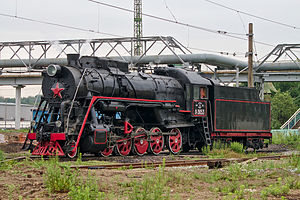Soviet locomotive class L
| Soviet locomotive class L | |||||||||||||||||||||||||||||||
|---|---|---|---|---|---|---|---|---|---|---|---|---|---|---|---|---|---|---|---|---|---|---|---|---|---|---|---|---|---|---|---|
 Locomotive L-3653 near Moscow | |||||||||||||||||||||||||||||||
| |||||||||||||||||||||||||||||||
| |||||||||||||||||||||||||||||||
| |||||||||||||||||||||||||||||||
| |||||||||||||||||||||||||||||||
The Soviet locomotive class L (Russian: Л) was a Soviet main freight steam locomotive type. They were nicknamed Lebed, "Swan."[1]
Description
[edit]The L class 2-10-0 was the first Soviet locomotive to use Boxpok-type wheels, which were commonplace in steam locomotive design post-World War II. A casing between the dome and chimney covered a steam drier pipe.
History
[edit]It was designed and built by the Kolomna Locomotive Works shortly after World War II under supervision by L.C. Lebedyanski. It was originally designated Class P (for Pobeda, "victory"), but was redesignated Class L in honor of its designer.
In conjunction with the FD class 2-10-2, it was primarily used to haul mainline goods across the terrain of the Soviet Union. Over 4,000 L class locomotives were constructed from 1945-1955, and they operated with the Soviet Railways until 1975.
Today there are over 300 example of L class locomotives surviving in various states of repair in the former Soviet Union, constituting the single largest surviving class of locomotives in the world. Many are still in operating condition.[citation needed]
See also
[edit]References
[edit]- ^ Ross, David, ed. (2003). The Encyclopedia of Trains and Locomotives. Barnes & Noble, p. 206. ISBN 978-0-7607-9679-5.
